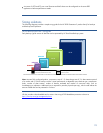
21
Zoning may not always be required for configurations that are already small or simple. Typically the larger the
SAN, the more zoning is needed. Use the following guidelines to determine how and when to use zoning.
Small fabric (16 ports or less)—may not need zoning.
Small to medium fabric (16 - 128 ports)—use host-centric zoning. Host-centric zoning is implemented by
creating a specific zone for each server or host, and adding only those storage elements to be utilized by
that host. Host-centric zoning prevents a server from detecting any other devices on the SAN or including
other servers, and it simplifies the device discovery process.
Disk and tape on the same pair of HBAs is supported along with the coexistence of array multipath software
(no multipath to tape or library devices on the HP D2D Backup System, but coexistence of the multipath
software and tape devices).
Large fabric (128 ports or more)—use host-centric zoning and split disk and tape targets. Splitting disk and
tape targets into separate zones will help to keep the HP D2D Backup System free from discovering disk
controllers that it does not need. For optimal performance, where practical, dedicate HBAs for disk and
tape.
Diagnostic Fibre Channel devices
For each D2D FC port there is a Diagnostic Fibre Channel Device presented to the Fabric. There will be one per
active FC physical port. This means there are two per HP D2D4000 series appliance that has two Fibre Channel
ports.
The Diagnostic Fibre Channel Device can be identified by the following example text.
Symbolic Port Name "HP D2D S/N-CZJ1440JBS HP D2DBS Diagnostic Fibre
Channel S/N-MY5040204H Port-1"
Symbolic Node Name "HP D2D S/N-CZJ1440JBS HP D2DBS Diagnostic Fibre Channel
S/N-MY5040204H"
A virtual driver or loader would be identified by the following example text:
Symbolic Port Name "HP D2D S/N-CZJ1440JBS HP Ultrium 4-SCSI Fibre Channel
S/N-CZJ1440JC5 Port-0"
Symbolic Node Name "HP S/N-CZJ1440JBS HP Ultrium 4-SCSI Fibre Channel S/N-
CZJ1440JC5"
In the above the S/N-CZJ1440JBS for all devices should be identical. If this is Node Port 1, the Node Name
string will be as above but, if Port 2, the Node Name string will end with “Port-2”. Often the diagnostic device
will be listed above the other virtual devices as it logs in first ahead of the virtual devices. The S/N-MY5040204H
string is an indication of the QLC HBA’s SN not any SN of an appliance/node.
At this time these devices are part of the StoreOnce D2D VTL implementation and are not an error or fault
condition. It is recommended that these devices be removed from the switch zone that is also used for virtual
drives and loaders.
Fibre Channel configuration via Web Management Interface
Full details on how to use the Web Management Interface to create virtual libraries and assign them to one of the
two ports on the appliance (Port 0 and Port 1) are provided in the HP D2D Backup System user guide.
There is a page on the Web Management Interface that allows you to view and edit the Fibre Channel SAN
settings, if necessary. It shows FC settings for each port on the appliance. The editable fields are:
Speed: The default is Auto, which is the recommended option. For users who wish to fix the speed,
other available values are 8Gbs (D2D4312 and D2D4324 only), 4Gbs, 2Gbs and 1Gbs.
Configuring a slower speed can impact performance.
Topology: The default is Auto, which is the recommended option. Loop, where the D2D appliance
simulates a large number of FC devices, and N_Port, when a single target device creates many
virtual devices on a fabric attach port, are also supported. N_Port requires the switch port to
support NPIV (N_Port ID Virtualisation).


















